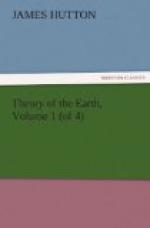We have thus, in the examination of coal strata upon chemical principles, received a certain lesson in geology, although this does not form a proper distinction by which to specify those strata in general, or explain the variety of that mineral. For, in this manner, we could only distinguish properly two species of those strata; the one bituminous or inflammable; the other proper coal, burning without smoke or flame. Thus it will appear that, as this quality of being perfectly charred is not originally in the constitution of the stratum, but an accident to which some strata of every species may have been subjected, we could not class them by this property without confounding together strata which had differences in their composition or formation. Therefore, we are led to inquire after some other distinction, which may be general to strata of fossil coal, independent of those changes which this substance may have undergone after it had been formed in a stratum.
Perfect mineral coal being a body of undistinguishable parts, it is only in its resolution that we may analyse it, and this is done by burning. Thus, in analysing coal by burning, we have, in the ashes alone, that by which one species of coal may be distinguished from another; and, if we should consider pure coal as having no ashes of itself, we should then, in the weight of its ashes, have a measure of the purity of the coal, this being inversely as the quantity of the ashes. Now, though this be not accurately true, as the purest coal must have some ashes proper to itself, yet, as this is a small matter compared with the quantity of earthy matter that may be left in burning some species of coal, this method of analysis may be considered as not far removed from the truth.
But, in distinguishing fossil coal by this species of chemical analysis, not only is there to be found a perfect or indefinite gradation from a body which is perfectly combustible to one that is hardly combustible in any sensible degree, we should also fall into an inconveniency similar to that already mentioned, of confounding two things extremely different in their nature, a bituminous body, and a perfect charcoal. Thus, if we shall found our distinction upon the fusibility and different degree of having been charred, we shall confound fossil coals of very different degrees of value in burning, or of very different compositions as strata; if, again, we found it upon the purity of composition, in judging from the ashes, we shall confound fossil bodies of very different qualities, the one burning with much smoke and flame, the other without any; the one fusible almost like wax, the other fixed and infusible as charcoal.
It will now appear, that what cannot be done in either the one or other of those two methods, may in a great degree, or with considerable propriety, be performed in employing both.
Thus, whether for the economical purposes of life, or the natural history of fossil coal, those strata should be considered both with regard to the purity of their composition as inflammable matter deposited at the bottom of the sea, and to the changes which they have afterwards undergone by the operation of subterranean heat and distillation.




